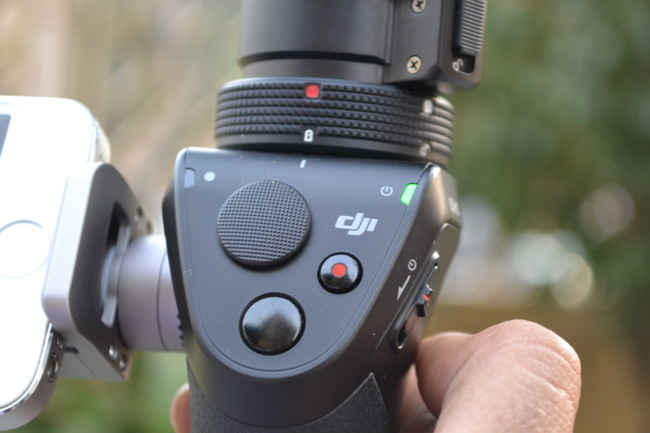DJI Osmo Review : First Person Shooter
The DJI Osmo is novel, beautifully built and excellent in a number of ways. Its stabilisation is brilliant, and the low levels of noise truly takes it to another level. However, there are limitations. There is a noticeable lack of sharpness in what it shoots, the companion app is rather heavy, and the battery stamina is a major difficulty. Plus, at Rs. 57,995, the DJI Osmo is not strictly inexpensive. The Osmo will find a niche for itself among its takers, and it certainly excels in performance. But, is it worth investing nearly 60k on it? For me, it definitely is. You, however, will surely find a DSLR like the Nikon D5500 or an advanced compact like the Sony RX100 IV more appealing, depending upon your usage.
The Gimbal
The main star of the DJI Osmo is the handheld stabilised gimbal that houses the camera’s base, control buttons and orientation trigger. The base of the gimbal houses the camera’s battery, and opens with an interlocking flap. The rear of the gimbal, on which the palm rests, has a smooth curve and is rubberised to improve grip. It sits on the palm just perfectly, and bends outwards to the platform that neatly houses the controls for the Osmo’s camera body. To the right of the control platform is the power/standby switch. The outer side of the gimbal is not rubberised, and houses the orientation/camera lock trigger. Keeping it pressed locks the camera to its position, double-tapping it directs the camera to face the front and triple-tapping moves it towards the holder’s face.
The Osmo is a startling stabiliser, to the extent that videos shot by the Osmo looks like the view that you would see in a first-person shooter video game. There is a sense of finesse to its build, and gives the camera a noticeable grace to function upon. The controls are well calibrated, and the buttons are responsive to input. You get three buttons (apart from the orientation trigger) to operate the camera with — an omnidirectional joystick, a still photography shutter button and a video recording button, all laid out with ample space for the thumb to rest. To the left of the gimbal is the clasp to hold smartphones, which is one of the aspects that did not really impress.
Nevertheless, the Osmo operates incredibly smoothly. The entire module connects to smartphones with WiFi, and works via the DJI Go app. The Osmo’s gimbal body is made of plastic, but the added weight of the device contributes to making it feel premium. Once you get to using it, there is a slight, noticeable lag between the actions on the buttons and joystick, and the camera’s response. At the best, the DJI Osmo’s controls have a 0.2 seconds lag between the input and taking effect on the camera, and right after startup, can go up to nearly one second. There is a similar overall lag with the trigger’s operations, and the app as well. Upon startup, the DJI Go app takes nearly 2-3 seconds to orient itself and sync with the actual camera feed. The trigger responds immediately when you use it to lock it to the camera’s mean position, but the double- and triple-taps take 0.5 seconds to respond on average.
The gimbal’s mechanism, above the hand grip, is sublime. The mechanism has triple lock mechanism, the first lock being for the rotating base that allows the DJI Osmo to rotate by 360 degrees. There are two demarcations on the base — the red line points at where the Osmo stops rotating, and the white line marks the lock position. The second and third locks are on the vertical and horizontal arms that hold the camera. To keep the suspended camera in place when not in use, the dual locks are sturdy, and at the same time, are easy to unlock. The entire mechanism that facilitates the Zenmuse X3 camera’s all-round movements is simply excellent, allowing all-round movement of the camera with impressive precision and no noticeable aberrations. This massively aids shooting smooth videos across rough terrain, and there are no squeaks in the hinges. In underslung mode (unlocked camera with low hand grip), the DJI Osmo gimbal smoothens sudden hand movements too, wrapping up its stance of being an incredible handheld stabiliser.
The only majorly questionable aspect of the Osmo is the smartphone holder. While the clasp is made of brushed metal and feels reasonably sturdy, after about a month’s usage, the clasp’s base became slightly loose, and keeping it in place became difficult. It does a good job of firmly keeping your smartphone, working as the Osmo’s live viewfinder, in place, but itself became loose from its base, and had to be repeatedly bolted tight, to keep it firm. In a device that excels with performance, this is a noticeable flaw.
Video and Imaging performance
The DJI Osmo camera module uses Sony’s Exmor R CMOS sensor. The 1/2.3-inch sensor can shoot 12.4-megapixel maximum resolution stills, and videos at 4K (3840×2160 pixels, 24/25 fps), Full HD (1920×1080 pixels, 24/25/30 fps) and HD (1280×720 pixels, 24/25/30 fps). It uses a 20mm (35mm-equivalent) f/2.8 lens, and the electronic shutter goes to the slowest of 8”, and fastest of 1/8000”. It can do Bulb, while in Manual mode. ISO levels go up to a highest of 1600 for still photographs, and 3200 for videos.
While all of this gives rise to a rather average configuration on paper, where the DJI Osmo excels is in stabilised video. The stabilised videos add that extra bit of fluidity that you would otherwise require a separate rig or a track to shoot on. Coupled with its excellent hand grip and the smooth, modular mechanism, the DJI Osmo makes for a perfect camera if you are setting up your own video production house. The added 4K video recording capability also gives you the option to shoot semi-professional videos, cars, bikes, or even action sequences and run chases. The stabiliser handles sharp bumps and brakes with ease, and yet, leaves the sense of uneven ground on the video. For instance, when you walk, there is the noticeable fluid motion in the video, which gives a rustic element to your video.
In terms of video quality, the outright video quality out of the DJI Osmo will not make your jaws drop, but it arguably good. While it retains original colours and contrast levels, there is a lack of overall sharpness in the video, especially when you record in 720p (HD). 1080p and 4K resolution, obviously, does much better jobs and retaining the actual parameters of colour, contrast and sharpness. There is no noticeable interpolation in the videos, and the noise-reduction algorithm actually does an impressive job. Even in dark, low-light situations, the DJI Osmo processes deeper blacks and sharp contrast, without attempting to light up the overall frame, and hence, keeping out noticeable grains. This is an excellent aspect, one that impresses more than the overall video quality of the DJI Osmo. It gives you the original colours from your subject, leaving you with a lot of room to edit, post-process and use your footages for multiple purposes — the true mark of a video-oriented camera. For most such cameras, ISO performance is highly pivotal, and the DJI Osmo succeeds in being excellent at suppressing noise.
One aspect that we realised with the DJI Osmo is its tendency to make frames darker while being operated in auto mode. It also takes a significant second extra to adjust to changing light environment, a crucial reason for shooting in auto. Once you step out into bright sunlight from indoor fluorescent lighting, the DJI Osmo takes nearly 3 seconds to adjust to the surroundings. While the resulting effect looks more like a default dip-to-white or fade-to-black (depending on which environment you are moving from and to), video enthusiasts looking at the Osmo for professional reasons would not be too fond of this.
Overall, the DJI Osmo is a competent video shooter, one that does a brilliant job of preserving colour coordinates and negate noise from videos, but takes time to adjust to light environments because of its algorithm. Additionally, there is always the split-second lag between using the controls and the camera responding to your actions. You will also require to spend a lot of initial time to really grasp the fluidity of the joystick and figure out exactly how lightly you will require to use it to get the smoothest movement out of the camera head, so there is a steep learning curve before you actually become absolutely confident of taking out the Osmo to shoot the season’s biggest derby. The biggest trump card, of the Osmo, is its stabiliser, which gives excellent stabilisation to any kind of movement. Check out the videos below, shot in varying circumstances, for video samples of the DJI Osmo.
In terms of photography, the DJI Osmo is not exactly focussed around photography, and that somewhat shows. While the images share the same aspect of preserving colour details from its source, there is an overall lack of sharpness. Add to the fact that stabilisation occurs from the gimbal and not the lens itself (slightly ironic), you will need to hold the camera very steady or place it on firm ground to obtain your shot, particularly under low light or dusk environments. The noise reduction algorithm plays its magic here, too, and the DJI Osmo performs really well under low light situations, especially considering its small sensor. One good aspect is the fit-by-default filters on top of the lens of the DJI Osmo, which helps if you are shooting in very bright or reflective environments, or a waterfall.
Check out the image samples below for more details.
DJI GO app
The DJI Go app for iOS (the one that we primarily worked on) is quite neat, and is well-formatted to work as an able viewfinder with all settings close to your hand. You get separate toggles to switch between auto, priority and manual, and from within that, you can control shutter speed and ISO. Accessing the album is also a fairly straightforward affair, and unlike the camera itself that takes a while to get used to, the app is a familiar interface for all smartphone photographers. One good thing about the app is that it is responsive and fast, and actually contributes to the learning curve of the DJI Osmo. It helps you figure out more about the camera, speeding up the process of you getting used to it. Content is stored on a microSD card (16GB included), and you will either need to sync it to your phone via WiFi or transfer via a microUSB cable, depending on how you wish to use it. So far, quite convenient.
As a downside, though, it is large in size and heavy on resources, and may slow you down if you wish to immediately skip to your email or messaging for some urgent correspondence. The DJI Go app gives you the portal to control multiple DJI equipment, and also comes with tutorials and newsletters, keeping you in touch with the company and its works.
Battery Life
The DJI Osmo’s primary concern, amid all the excellence, is battery life. On average usage with occasional (around 15-20 minutes of Full HD) video recording and shooting stills, you can burn the Osmo out in as fast as only 30 minutes. On continuous shooting, one aspect that you will get is the amount of heat that it generates while operating. For continuous shooting at 4K, about three minutes of shooting dropped the battery by as much as nearly 35%, which is a deterrent if you are considering taking it out for a weekend to a distant location without accessing to power. However, considering that many who go for the Osmo may shoot at Full HD and shoot stills for most of the time, doing so does not massively aid the Osmo’s battery stamina by much. At a stretch, you will be able to record about 30-40 minutes of Full HD video and shoot around 50-60 stills, giving you overall usage time of only about an hour, upon constant usage. To save on battery, I kept shooting 2-3 minutes of video and 5-10 stills and keep switching the device off, and after two days, I managed only about 20 minutes of cumulative Full HD/4K footage and 40 stills, which is somewhat underwhelming. This is a major concern, and you will need to be aware and adjust to this, to make the most of the DJI Osmo.
Bottomline
The DJI Osmo is novel, beautifully built and excellent in a number of ways. Its stabilisation is brilliant, and the low levels of noise truly takes it to another level. However, there are limitations. There is a noticeable lack of sharpness in what it shoots, the companion app is rather heavy, and the battery stamina is a major difficulty. Plus, at Rs. 57,995, the DJI Osmo is not strictly inexpensive. The Osmo will find a niche for itself among its takers, and it certainly excels in performance. But, is it worth investing nearly 60k on it? For me, it definitely is. You, however, will surely find a DSLR like the Nikon D5500 or an advanced compact like the Sony RX100 IV more appealing, depending upon your usage.












